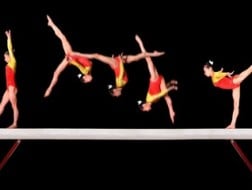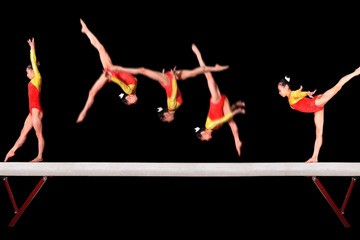The 5 biggest issues I see going on in the body when someone comes to me for personal training.

Following are the 5 biggest problems I generally see when someone who is brand new or fairly new to exercise comes to me for training. I consider these things to be fundamental issues, as if these aren’t fixed or sorted, my clients won’t be able to get the results they need. Getting to the core of these issues from the start is important to me. Most of these things overlap and affect each other as well.
Generally someone who is completely new to exercise, or who hasn't done anything physically active in awhile will have at least 2-3 (if not more) of the following issues. Once I am able to get a basic understanding of their bodies and pinpoint the areas that they need the most work in their body, I then tailor a program to suit their individual needs and to continue working on any problems.
I feel that it’s important for us, as trainers and coaches, to be able to look out for these things, and fix them before we advance our clients to the next level of training. Of course I know that exercise form will not always be perfect, especially when I'm working with a relatively new client. I understand that they will forget technique cues and make mistakes from time to time. It's a learning process. But at least if I get them moving better and knowing their body better, they will be able to make progress.
Something else that I find important (which I need to remember more often myself) is not overwhelming newer clients with too many cues at once. They're often better off hearing only 2-3 cues for an exercise. Take it one day, one step at a time.
If you train yourself and you don’t have a training partner or a personal trainer available, you might also find this post helpful.
1.) Poor posture
Most clients that I work with are those with 9-5 desk jobs at which they are required to sit all day long at a desk. For as long as I’ve been a trainer I have been battling poor posture with my clients. To reference an idea I heard at a postural seminar I went to earlier this year, I try to remember the 23/1 rule, which is that while I get to help some for 1 hour out or so of their day, they have the other 23 hours to screw it up. Keeping this in mind, I try my best to give them tools and cues that relate to everyday life, as well as some simple stretches and mobility drills they can do on their own (preferably something easy that does not require equipment, that they will actually bother doing). This will improve their quality of life so much more than just doing their personal training session, and leaving it at that.
Trainers and coaches often say "mobility before stability" and while I agree with that, I think part A. is missing: Alignment. Alignment before mobility, before stability.
2.) No awareness or body control.
This is a big one! Body awareness is responsible for the body's abilities to coordinate motion (such as throwing a ball) and the body's awareness of where it is in time and space (think of dancing). When you see dancers moving together it is largely kinesthetic awareness that allows them to move in harmony together instead of bumping into each other.
Because a lot of the people I train do not spend most of their day moving or exercising, very few have the knowledge of their own bodies to control and use it exactly the way they should. It becomes clear to me that with some deconditioned clients it is not only a lack of training or ability, but also a lack of understanding of how to manipulate their own bodies, and use their system to work for them.
In order to correct things (like one’s posture, as I said above), I need to first get the person to feel exactly what moves what, and how it’s all connected. Often experience alone will help to fix this. Have you ever seen a person who is new to exercise do a barbell squat or deadlift next to an experienced lifter? The newbie usually looks awkward and uneasy with the weights. Sometimes they are performing the actual movement with okay form, and it’s not exactly a technique problem; it’s just an overall awkwardness. The movement is not smooth and controlled. This is because they have not developed proper kinesthetic awareness in their body yet.
I like to help my clients develop this faster and more effectively by using specific cues and describing to them what muscles they should be feeling worked, what should be squeezed, what should be activated, etc etc during each exercise. Even the most uncoordinated, accident-prone klutz’s, can drastically improve their skills, agility and coordination through becoming more aware of their body and how to move it properly.
Olympic weightlifters have an incredibly high degree of body awareness. They need to be able to take a fully loaded bar off the ground, hit the triple extension, and land on their heels with the bar overhead in a solid position.
Gymnasts also have unbelievable levels of body awareness.
3.) An under-used, weak posterior chain
The hamstrings, glutes, upper and lower backs, as well as the rear shoulder muscles, all seem to be neglected in most people’s daily lives. Once I can get a client to feel and use their posterior chain, their power output shoots through the roof. Sometimes it’s an awareness thing (as per my point above about kinesthetic awareness,) but usually it’s that the posterior muscles are under-trained and under-utilized, so they need to be built up, and switched on properly before they can be effective. One easy way I make sure to do this is by including a lot of posterior training and pulling movements in my clients’ sessions. In fact, for every 1 pushing movement I generally do two pulling movements.
4.) Weak core muscles
All the fundamental movements are deeply rooted in having a strong and stable core. Being able to maintain proper posture while moving loads is the fundamental technique in lifting weights. If you lose your position easily, you not only become less effective in moving the weight (and aren’t able to move as much weight) but you also risk injury. I make sure to teach my clients how to maintain proper neutral spine, as well as breathing techniques to use during exercise, and also how to stablise the core. Sometimes I will add some supplemental exercises depending on individual weakness to help strengthen their abdominals, hip flexors and lower backs.
4.) Lack of mobility
Once I’ve got a client moving in a variety of exercises, it becomes very clear to me where their range of motion is limited or non existent. A lot of people don’t even realise how much they are inhibited on a daily basis by their own lack of mobility in a particular joint. To fix it we have to take the necessary steps of stretching, self-release techniques, and challenging that range of motion through a variety of functional movements.
Remember that mobility drills and stretching need to be done on a regular basis for them to work and make a difference.
So those are the 5 biggest issues I see in the majority of people who are new to exercise. Not everyone has these problems, of course, but the vast majority of clients I have trained over the years have come to me with some of these issues. When I focus on these things, discuss them and work on fixing them with my clients, they become so much more aware of what is going on in their body. Often just that awareness makes a huge difference in sorting these things out.
Remember as well, if you have a sitting down job, try and sneak in some mobility and flexibility work throughout your day, even just getting up and moving around will make a difference. All the times you do it will add up and will stack the odds in your favour. Get in some hip openers, get down in the squatting position and hold it there for a few minutes. Instead of emailing the person a couple cubicles over, get out of your chair and walk over. Those little differences add up to big numbers at the end of the day. Doing things like this every day could help save your hip flexors, loosen up your tight hamstrings and a tight lower back and give you back some lost flexibility.
Be mobile and unbroken!
Join the other 10,000+ who get my best fitness, diet & mindset tips.



Comments